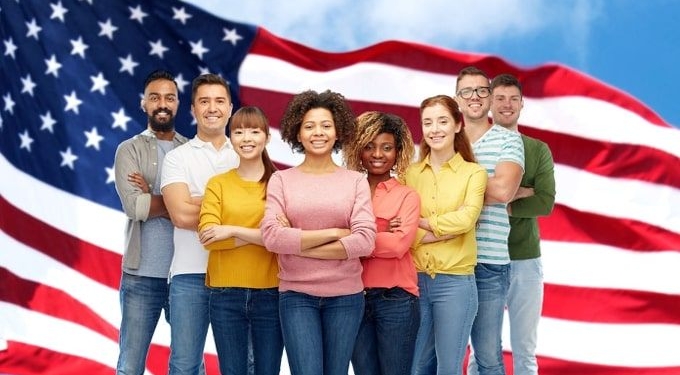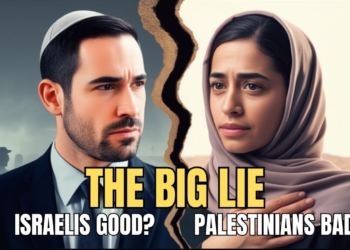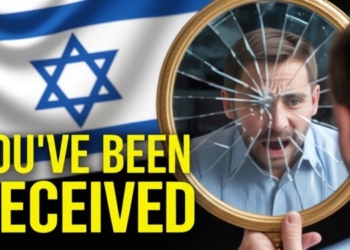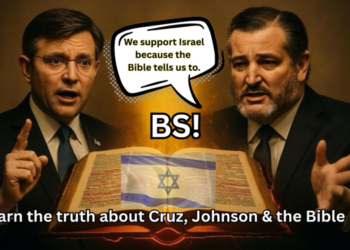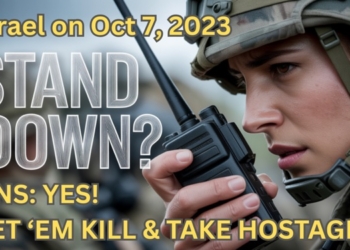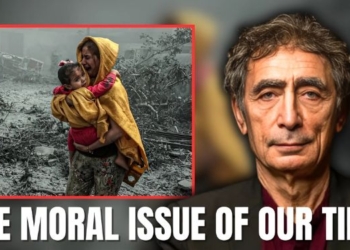
By Zaid Jilani | Greater Good Magzine
The 2002 film My Big Fat Greek Wedding resonated with millions of people around the world—it retains the title of the highest-grossing romantic comedy in history. Why? Perhaps because its central conflict is one that countless couples have endured.
In the film, Greek-American Toula Portokalos falls in love with a non-Greek named Ian Miller. What ensues is a classic clash of cultures, as Miller struggles to win over Portokalos’s hostile family.
Ultimately, the couple overcomes this barrier and they happily wed. At the wedding, Toula’s father explains how he came to terms with the reality that his daughter would be part of an intercultural family.
He notes that the root of the word “Miller” is Greek for apple, and the name Portokalos comes from the Greek word for orange. He concludes, “So, okay, here tonight we have, uh, apple and orange . . . we all different, but in the end, we all fruit!” The wedding party applauds in approval.
This is an example of what social scientists call “superordinate identity.” Portokalos acknowledges that the two sides of the new family come from distinct and proud cultures—an apple and an orange—but that they also share a larger, superordinate identity in common: fruit! Toula and Ian can value the cultures they grew up in but also embrace a larger shared culture they will create with their new family.
Focusing on shared identities is a very important way for people in diverse societies to bridge their differences without shedding or suppressing what makes them different in the first place. Doing so allows us to come together with people who we previously imagined we had nothing in common with—which research suggests can open the door to greater empathy and cooperation. Today, organizations like Better Angels and Citizen University are putting these academic insights to work in trying to remind divided Americans what they have in common.
The roots of the in-group theory
In 1993, a team of researchers laid out what they called the “common in-group model” of reducing bias. Samuel Gaertner and colleagues noted that many of society’s prejudices were based not just on contempt for out-groups, but on favoring in-groups.
Thus, they hypothesized that “if members of different groups are induced to conceive of themselves as a single group rather than two completely separate groups, attitudes toward former out-group members will become more positive through processes involving pro-in-group bias.”
Through a range of studies and experiments involving both in-groups and out-groups, Gaertner and his collaborators found that “in general, stronger conceptions of the aggregate as a single group directly related to more positive feelings toward out-group members.”
In one of these studies, the team examined a multi-ethnic high school and surveyed students about how they conceived of relations within the school. They found that the degree to which the students at the school felt like one group was “significantly related, in turn, to more positive feelings toward out-groups. . . . Also, the degree to which students perceived the school to be composed of different groups was negatively related . . . to good feelings toward the out-groups.”
More recent studies have found similar effects from being able to imagine that two distinct groups are actually part of a larger shared identity. In 2005, a team of British researchers studied how social group memberships influence behavior. They focused on a popular British pastime: soccer.
They set up a pair of experiments based on the rivalry between two popular teams: Manchester United and Liverpool FC. In the initial experiment, participants—all of whom were partisans for one of those two teams—were presented with the opportunity to help an injured jogger. The experimenters found that the participants were more likely to help the jogger if he or she was wearing the jersey of the participant’s favorite soccer team, as opposed to when the jersey belonged to the rival team.
In the subsequent experiment, the participants were reminded of their identities as soccer fans—a superordinate, shared identity. As might be expected, they were more likely to help the injured fan of a rival team than they were to help someone who wasn’t a soccer fan at all.
In other words, the participants were redefining their in-group: In the first experiment, they defined their in-group as fans of a particular soccer team; in the second, they identified with people who enjoyed the same sport. In both instances, they were more likely to assist someone from the in-group than someone from their perceived out-group.
One of the researchers, University of Lancaster social psychologist Mark Levine, argues that their finding has implications well beyond soccer. “Making these categories more inclusive, increasing the boundaries of shared identity, is the thing which increases the likelihood of you having a much more inclusive sense of social obligation,” he says. “These are people who are part of your group and you need to help them.”
One of the challenges of focusing on shared identities, however, is knowing when and how to deploy this skill. There are circumstances where it may not be appropriate to focus solely on shared identities, especially when a minority group is being denied some rights or privileges by a majority group.
“I think often . . . promotion of shared identities can undermine the willingness of people to engage in collective action,” Levine says. If they feel that their identities or concerns are being made invisible by the superordinate identity, “it makes the minority group less keen to engage in social change and social protest.”
Appealing to our “better angels”
These insights haven’t stayed in academic journals. Today in the United States, political polarization has degraded the concept of a shared identity among Americans, to the extent that even cross-partisan marriages are increasingly uncommon. There are a handful of organizations working to remind Americans what they have in common.
One of them is Better Angels, which started after the negative and polarizing 2016 election. Ten Trump backers and 11 Clinton supporters got together in a space in South Lebanon, Ohio, to talk about their common ground. The supporters learned that they liked each other, and they wanted to continue meeting. Soon, this collaboration grew into Better Angels, which holds events all over America to encourage people to be able to find commonality and better understand people who are on the other side of the political aisle from them. It draws its name from Abraham Lincoln’s first inaugural address, where he issued a passionate plea to avoid the growing conflict between the North and the South.
We are not enemies, but friends. We must not be enemies. Though passion may have strained it must not break our bonds of affection. The mystic chords of memory, stretching from every battlefield and patriot grave to every living heart and hearthstone all over this broad land, will yet swell the chorus of the Union, when again touched, as surely they will be, by the better angels of our nature.
One of the organization’s programs is the Red/Blue workshops. In a typical workshop, around half a dozen Republican-leaning citizens and half a dozen Democratic-leaning citizens get together and participate in exercises designed to build bridges. One sample exercise is called the “fishbowl,” where one of the two groups sits in the middle and discusses while the other group sits on the perimeter and quietly observes. The two groups then switch places. Afterward, both sides are invited to explain what they learned about the other.
John Wood, Jr., is the director of media development at Better Angels. He is the son of an African-American liberal mother and a white conservative father, and he considers both of these distinct identities as having shaped his worldview and personal identity.
Earlier in life, he held more liberal politics and supported the election of Barack Obama to the presidency; more recently, he adopted more conservative viewpoints and ran for Congress as a Republican in 2014.
To Wood, the project of building a shared American identity is not only what he has personally had to do, but a way out of much of the political polarization that has gripped the country. He believes that partisans have more in common than they believe.
“Something that seems pretty clear to me is that there do seem to be seminal themes or values that really do . . . jump across one side of the political aisle to the other,” he says. “Fundamentally, liberty and equality, or freedom and equality, and justice as well, are some of the primary examples. They just tend to express themselves in different ways in the context of politics.”
His concern is that American identity is sometimes claimed by one side or the other as if you cannot have an equal claim on America itself unless you hold certain beliefs.
“What’s happened is our political narratives have evolved in a way to where the two sides essentially say that there’s only one legitimately American expression of these value sets,” he says. “Therefore, if you don’t have a conservative vision of freedom or a liberal vision of equality, you’re not authentically American in the way you’re articulating these things.”
Wood recognizes the challenge of building a shared identity in this diverse country and doing so in a way that doesn’t make people feel like their subordinate identities are being trampled on.
“Implicit in the work of Better Angels is the idea that pluralism itself is kind of at the heart of American identity,” Wood says. They don’t insist that any participant pretend to be something they’re not. Instead, they try to facilitate increasingly constructive dialogues across groups, to move from what separates them to discover what they have in common.
Building a shared identity as citizens
The challenge, of course, is that the United States is an extremely diverse country. Citizen University (CU) was founded by civic activist Eric Liu in 2012 to try to bind Americans of all cultures and classes together with the concept of citizenship.
What is a citizen, according to CU?
“We are not talking about anything dealing with documentation status,” says Kayla DeMonte, a managing director at CU. Instead, CU takes “a more holistic view of folks who are contributing, members of their community, in public and civic life.” In order to build this sense of shared citizenship, much of the organization’s programming focuses on what DeMonte refers to as the “creed, the deeds, and the rituals that make up American civic life.”
One of their programs is called Civic Saturday, which is “meant to be a civic analog to a faith gathering,” DeMonte says. People from diverse backgrounds are brought together for around 90 minutes and they participate in activities designed to build a shared sense of community and citizenship, such as talking to their neighbors, singing together, and hearing poetry and civic sermons together. Civic Saturdays began in Seattle where CU is based, but have been held in 30 cities since.
CU responds to the challenge of building a shared identity in a heterogeneous country by casting a wide net, defining its in-group as broadly as possible. DeMonte explains:
One of the things that we talk about in terms of . . . an “us” and a “them,” is that those who are in the “us” group are those who are choosing to participate like a citizen. That means serving a gathering, joining together, communicating and arguing with each other in a productive way. And the “them” are those who don’t. The great thing about that is that anybody can choose to become one of us by deciding to live like a citizen.
It can be difficult to establish a shared identity, particularly in a heterogeneous society that includes all manner of people. And it isn’t necessarily always the best approach—as Levine pointed out, social change movements often have to emphasize the difference in order to call attention to inequities.
My Big Fat Greek Wedding was loosely inspired by the life of the star of the film, Nia Vardalos, a Greek-Orthodox woman who married a non-Greek man. “I have heard every single person’s interfaith marriage story,” said Vardalos during an interview to promote the film. “Whether they married within their faith or outside their faith, people are telling me, ‘That’s my family’ or ‘That’s my relationship.’” Though we tend to think of Americans as more divided than ever, in fact, inter-racial and inter-ethnic marriages in the United States have hit an all-time high. This suggests that more and more apples and oranges in America are embracing a common identity as fruit—a real-world fact that should give us even more hope than did the conclusion of My Big Fat Greek Wedding.



